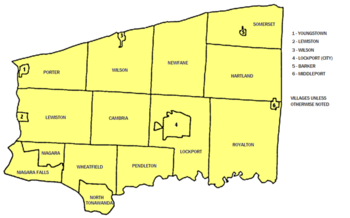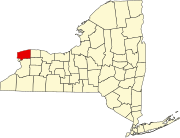History
When counties were established in the New York colony in 1683, the present Niagara County was part of Albany County. Prior to the British, the area was part of New Netherland. [5]
Albany was an enormous county, including the northern part of New York State as well as all of the present State of Vermont and, in theory, extending westward to the Pacific Ocean. This county was reduced in size on July 3, 1766, by the creation of Cumberland County, and further on March 16, 1770, by the creation of Gloucester County, both containing territory now in Vermont. [6]
On March 12, 1772, what was left of Albany County was split into three parts, one remaining under the name Albany County. One of the other pieces, Tryon County, contained the western portion (and thus, since no western boundary was specified, theoretically still extended west to the Pacific). The eastern boundary of Tryon County was approximately five miles west of the present city of Schenectady, and the county included the western part of the Adirondack Mountains and the area west of the West Branch of the Delaware River. The area then designated as Tryon County now includes 37 counties of New York State. The county was named for William Tryon, colonial governor of New York. [7]
In the years prior to 1776, most of the Loyalists in Tryon County fled to Canada including the likes of local judge John Butler and militia commander Sir John Johnson. [8] In 1784, following the peace treaty that ended the American Revolutionary War, the name of Tryon County was changed to honor the general, Richard Montgomery, who had captured several places in Canada and died attempting to capture the city of Quebec, replacing the name of the hated British governor. [9]
In 1789, Ontario County was split off from Montgomery. In turn, Genesee County was created from Ontario County in 1802. [10]
Niagara County was created from Genesee County in 1808. It was, however, larger than the present Niagara County even though it consisted of only the Town of Cambria. [11]
From 1814 to 1817, records of Cattaraugus County were divided between Belmont (the seat of Allegany County) and Buffalo (then in Niagara County). Niagara County governed the western portion of Cattaraugus County, then known as the town of Perry. [12]
In 1821, Erie County was created from Niagara County. [13]
The county has a number of properties on the National Register of Historic Places. [14]
Geography
According to the U.S. Census Bureau, the county has a total area of 1,139 square miles, of which 522 square miles (1,350 km2) is land and 617 square miles (1,600 km2) (54%) is water. [15]
Niagara County is in the most western part of New York State, just north of the city Buffalo and1,140 square miles (3,000 km2) bordering Lake Ontario on its northern border, and the Niagara River Canada on its western border. [16]
The county's primary geographic feature is Niagara Falls, the riverbed of which has eroded seven miles south over the past 12,000 years since the last ice age. The Niagara River and Niagara Falls, are in effect, the drainage ditch for four of the Great Lakes which constitute the world's largest supply of fresh water. [17] The water flows north from Lake Erie, then through the Niagara River, goes over Niagara Falls, and then on to Lake Ontario and the St. Lawrence River, eventually emptying into the North Atlantic Ocean. [18] Today, tourists and visitors to the Falls see a diminished flow of water over the Falls, since a portion of the flow has been diverted for hydroelectric power purposes. Both the American and Canadian side of the Niagara River have massive electrical power plants. [19]
The Niagara Gorge is the path Niagara Falls has taken over thousands of years as it continues to erode. [20] Niagara Falls started at the Niagara Escarpment which cuts Niagara County in half in an east–west direction. North of the Escarpment lies the Lake Ontario plain, which is a fertile flatland used to grow grapes, apples, peaches and other fruits and vegetables. The grape variety Niagara, source of most American white grape juice but not esteemed for wine, was first grown in the county, in 1868. Viticulture, or wine culture has begun to take place, with several wineries below the escarpment. This has helped to improve the depressed economy of the region.
Adjacent counties and areas
State protected areas
- De Veaux Woods State Park, north of the City of Niagara Falls.
- Devil's Hole State Park, immediately north of the City of Niagara Falls.
- Fort Niagara State Park, located at the mouth of the Niagara River.
- Earl W. Brydges Artpark State Park, in the Town of Lewiston.
- Four Mile Creek State Park, on the shore of Lake Ontario.
- Golden Hill State Park, on the shore of Lake Ontario.
- Hartland Swamp Wildlife Management Area—a conservation area in the Town of Hartland.
- Joseph Davis State Park, along the Niagara River.
- Niagara Reservation State Park, in the City of Niagara Falls.
- Reservoir State Park, south of the power reservoir.
- Tonawanda Wildlife Management Area, partly in the Town of Royalton.
- Wilson-Tuscarora State Park, on the shore of Lake Ontario.
Demographics
Historical population| Census | Pop. | Note | %± |
|---|
| 1810 | 8,971 | | — |
|---|
| 1820 | 22,990 | | 156.3% |
|---|
| 1830 | 18,482 | | −19.6% |
|---|
| 1840 | 31,132 | | 68.4% |
|---|
| 1850 | 42,276 | | 35.8% |
|---|
| 1860 | 50,399 | | 19.2% |
|---|
| 1870 | 50,437 | | 0.1% |
|---|
| 1880 | 54,173 | | 7.4% |
|---|
| 1890 | 62,491 | | 15.4% |
|---|
| 1900 | 74,961 | | 20.0% |
|---|
| 1910 | 92,036 | | 22.8% |
|---|
| 1920 | 118,705 | | 29.0% |
|---|
| 1930 | 149,329 | | 25.8% |
|---|
| 1940 | 160,110 | | 7.2% |
|---|
| 1950 | 189,992 | | 18.7% |
|---|
| 1960 | 242,269 | | 27.5% |
|---|
| 1970 | 235,720 | | −2.7% |
|---|
| 1980 | 227,354 | | −3.5% |
|---|
| 1990 | 220,756 | | −2.9% |
|---|
| 2000 | 219,846 | | −0.4% |
|---|
| 2010 | 216,469 | | −1.5% |
|---|
| 2020 | 212,666 | | −1.8% |
|---|
|
As of the census of 2010, there were 216,469 people, 87,846 households, and 58,593 families residing in the county. The population density was 420 inhabitants per square mile (160/km2). There were 95,715 housing units at an average density of 183 units per square mile (71/km2). The racial makeup of the county was 90.70% White, 6.15% Black or African American, 0.94% Native American, 0.58% Asian, 0.02% Pacific Islander, 0.40% from other races, and 1.21% from two or more races. 1.33% of the population were Hispanic or Latino of any race. 23.6% were of German, 18.1% Italian, 11.3% Irish, 11.2% Polish and 8.3% English ancestry. 94.5% spoke English, 1.6% Spanish and 1.0% Italian as their first language.
There were 87,846 households, out of which 30.90% had children under the age of 18 living with them, 50.30% were married couples living together, 12.30% had a female householder with no husband present, and 33.30% were non-families. 28.60% of all households were made up of individuals, and 12.00% had someone living alone who was 65 years of age or older. The average household size was 2.45 and the average family size was 3.03.
In the county, the population was spread out, with 24.70% under the age of 18, 8.50% from 18 to 24, 28.40% from 25 to 44, 23.10% from 45 to 64, and 15.40% who were 65 years of age or older. The median age was 38 years. For every 100 females there were 93.30 males. For every 100 females age 18 and over, there were 89.50 males.
The median income for a household in the county was $38,136, and the median income for a family was $47,817. Males had a median income of $37,468 versus $24,668 for females. The per capita income for the county was $19,219. About 8.20% of families and 10.60% of the population were below the poverty line, including 15.00% of those under age 18 and 7.30% of those age 65 or over.

Cattaraugus County is a county in Western New York, with one side bordering Pennsylvania. As of the United States 2020 census, the population was 77,042. The county seat is Little Valley. The county was created in 1808 and later organized in 1817. The county is part of the Western New York region of the state.
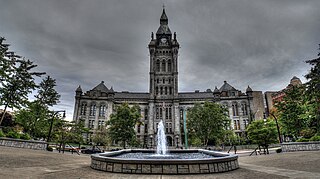
Erie County is a county along the shore of Lake Erie in western New York State. As of the 2020 census, the population was 954,236. The county seat is Buffalo, which makes up about 28% of the county's population. Both the county and Lake Erie were named for the regional Iroquoian language-speaking Erie tribe of Native Americans, who lived in the area before 1654. They were later pushed out by the more powerful Iroquoian nations tribes. The county is part of the Western New York region of the state.
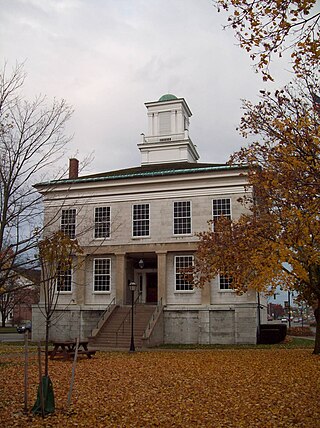
Genesee County is a county in the U.S. state of New York. As of the 2020 census, the population was 58,388. Its county seat is Batavia. Its name is from Seneca word Gen-nis'-hee-yo, meaning "the Beautiful Valley". The county was created in 1802 and organized in 1803. The county is part of the Finger Lakes region of the state.
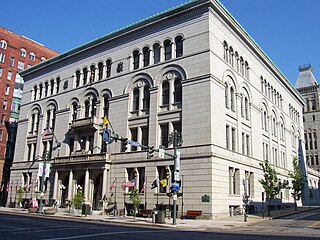
Monroe County is a county in the U.S. state of New York, located along Lake Ontario's southern shore. As of 2022, the population was 752,035, according to Census Bureau estimates. Its county seat and largest city is Rochester. The county is named after James Monroe, the fifth president of the United States. Monroe County is part of the Rochester, NY Metropolitan Statistical Area. The county is part of the Finger Lakes region of the state.
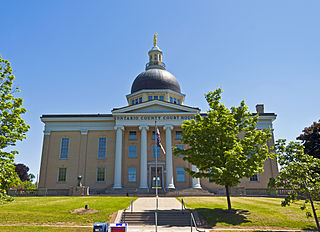
Ontario County is a county in the U.S. State of New York. As of the 2020 census, the population was 112,458. The county seat is Canandaigua. The county is part of the Finger Lakes region of the state.
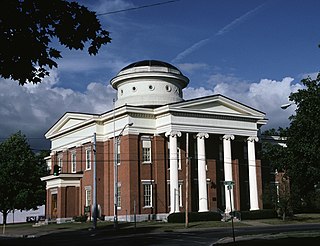
Oneida County is a county in the state of New York, United States. As of February 26, 2024, the population was 226,654. The county seat is Utica. The name is in honor of the Oneida, one of the Five Nations of the Iroquois League or Haudenosaunee, which had long occupied this territory at the time of European encounter and colonization. The federally recognized Oneida Indian Nation has had a reservation in the region since the late 18th century, after the American Revolutionary War.

Steuben County (stu-BEN) is a county located in the U.S. state of New York. As of the 2020 census, the population was 93,584. Its county seat is Bath. Its name is in honor of Baron von Steuben, a Prussian general who fought on the American side in the American Revolutionary War, though it is not pronounced the same. The county is part of the Southern Tier region of the state.

Orleans County is a county in the western part of the U.S. state of New York. As of the 2020 census, the population was 40,343. The county seat is Albion. The county received its name at the insistence of Nehemiah Ingersoll though historians are unsure how the name was selected. The two competing theories are that it was named to honor the French Royal House of Orleans or that it was to honor Andrew Jackson's victory in New Orleans. The county is part of the Finger Lakes region of the state.
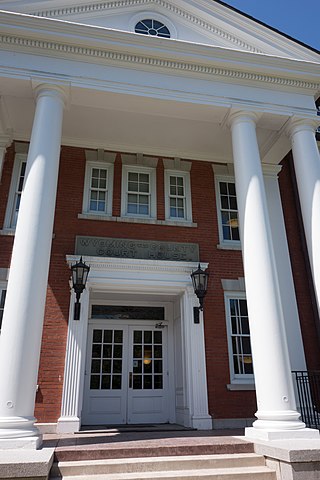
Wyoming County is a county in the U.S. state of New York in the state's western area. As of the 2020 census, the population was 40,531. The county seat is Warsaw. The name is modified from a Lenape (Delaware) Native American word meaning "broad bottom lands". Wyoming County was formed from Genesee County in 1841. Wyoming County is one of New York's mostly agricultural counties. With an estimated 47,500 dairy cows in the county, there are more cattle in Wyoming County than people. The county is part of the Finger Lakes region of the state.
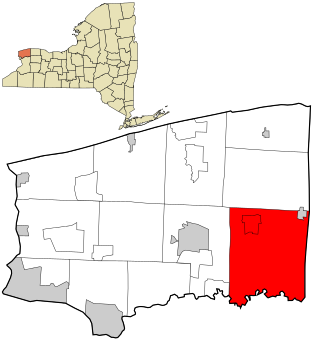
Royalton is a town in Niagara County, New York, United States. The population was 7,660 at the 2010 census.

Youngstown is a village in Niagara County, New York, United States. The population was 1,935 at the 2010 census. It is part of the Buffalo–Niagara Falls Metropolitan Statistical Area.

New York State Route 18 (NY 18) is an east–west state highway in western New York in the United States. It runs parallel to the south shore of Lake Ontario for most of its length between Niagara County and Monroe County. NY 18, which also passes through Orleans County, acts as a northerly alternate to NY 104, another east–west route that parallels NY 18 to the south on Ridge Road. The western terminus of NY 18 is at a complex grade-separated interchange with NY 104 outside the village of Lewiston. Its eastern terminus is at a junction with NY 104 in an area of Rochester known as Eastman Business Park.
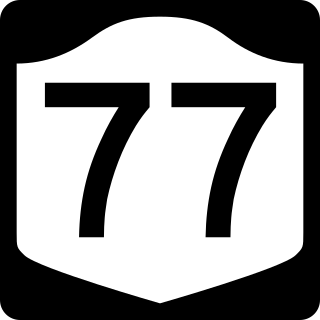
New York State Route 77 (NY 77) is a north–south state highway in the western part of New York in the United States. The highway runs for 46.28 miles (74.48 km) across mostly rural areas from an intersection with NY 78 and NY 98 in the Wyoming County town of Java to a junction with NY 31 near the city of Lockport in Niagara County. It connects to several of the region's major east–west roads, including U.S. Route 20 (US 20) and the New York State Thruway. In southwestern Genesee County, the route takes on added importance as it provides the most direct route between the Thruway and Darien Lake, Western New York's largest amusement park.

New York State Route 31E (NY 31E) is a 5.29-mile (8.51 km) state highway located in western New York in the United States. It serves as a northerly alternate route of NY 31 between the village of Middleport in eastern Niagara County and the nearby village of Medina in Orleans County. NY 31E connects to NY 31 at each end by way of a short overlap with NY 271 in Middleport. Most of NY 31E parallels the Erie Canal, and parts of the route run adjacent to the waterway. Outside of the two villages at each end, NY 31E traverses mostly rural areas of the towns of Royalton and Ridgeway.

The Great Lakes Seaway Trail, formerly named and commonly known as the Seaway Trail, is a 518-mile (834 km) National Scenic Byway in the northeastern United States, mostly contained in New York but with a small segment in Pennsylvania. The trail consists of a series of designated roads and highways that travel along the Saint Lawrence Seaway—specifically, Lake Erie, the Niagara River, Lake Ontario, and the Saint Lawrence River. It begins at the Ohio state line in rural Erie County, Pennsylvania, and travels through several cities and villages before ending at the Seaway International Bridge northeast of the village of Massena in St. Lawrence County, New York. It is maintained by the non-profit Seaway Trail, Inc.

The International Railway Company (IRC) was a transportation company formed in a 1902 merger between several Buffalo-area interurban and street railways. The city railways that merged were the West Side Street Railway, the Crosstown Street Railway and the Buffalo Traction Company. The suburban railroads that merged included the Buffalo & Niagara Electric Street Railway, and its subsidiary the Buffalo, Lockport & Olcott Beach Railway; the Buffalo, Depew & Lancaster Railway; and the Niagara Falls Park & River Railway. Later the IRC acquired the Niagara Gorge Railroad (NGRR) as a subsidiary, which was sold in 1924 to the Niagara Falls Power Company. The NGRR also leased the Lewiston & Youngstown Frontier Railroad.

The Buffalo–Niagara Falls Metropolitan Statistical Area is a metropolitan area, designated by the United States Census Bureau, encompassing two counties - Erie and Niagara - in the state of New York. It has a population of over 1.1 million people and is the second-largest metropolitan area in the state. As of the 2020 U S. census, the metropolitan statistical area (MSA) had a population of 1,166,902. The larger Buffalo Niagara Region is an economic zone consisting of eight counties in Western New York.
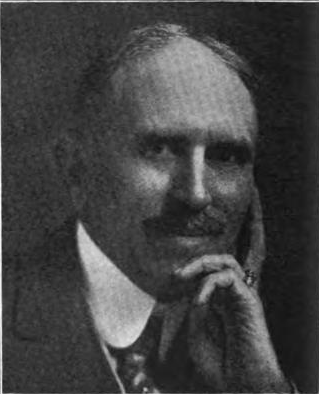
Frank Alonzo Dudley was an American lawyer, politician, hotelier and business owner associated with Niagara Falls, New York. Dudley established the United Hotels Company of America and the "Lewiston Heights" neighborhood in Lewiston, New York.





